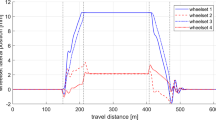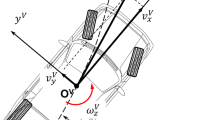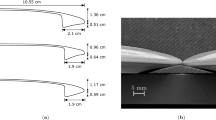Abstract
Due to the increased number of fatalities and injuries in motor vehicle accidents, it is crucial to study the kinematic and kinetic occupant response during collisions, specifically the head and neck response due to their vulnerable nature. In Part I we have addressed rear end collisions. In Part II we examine occupant response in frontal and lateral collisions. Two multibody dynamics models of the cervical spine of the 50th percentile male were developed and validated. The cervical spine was modeled as a series of rigid links connected through single and two degrees of freedom viscoelastic joints. In addition, finite element simulations of two compact sedan vehicle were conducted to capture realistic crash acceleration of the driver seat in frontal and lateral collision scenarios. Furthermore, finite element simulations were performed to capture the kinematic and kinetic response of a seated restrained male occupant subjected to the realistic seat accelerations in frontal and lateral collisions. Finally, the possibility of injury in frontal, lateral and rear collisions was evaluated. The evaluation of ligament injury risk shows high risk of injury at the interspinous ligament in frontal collision, at the anterior longitudinal ligament in rear collision and at the near-side capsular ligament in lateral collision. The highest vertebral fracture risks were found at the mid- and lower cervical spine in rear and lateral collisions. The outcomes of this work provide a better understanding of occupant injury mechanism during frontal, lateral and rear collisions which is essential to enhancing motor vehicle safety.













Similar content being viewed by others
References
Anderst, W., Baillargeon, E., Donaldson, W., Lee, J., Kang, J.: Motion path of the instant center of rotation in the cervical spine during in vivo dynamic flexion-extension. Spine (Phila. Pa. 1976) 38, E594–E601 (2013). https://doi.org/10.1097/brs.0b013e31828ca5c7
Arun, M.W., Humm, J.R., Yoganandan, N., Pintar, F.A.: Biofidelity evaluation of a restrained whole body finite element model under frontal impact using kinematics data from PMHS sled tests. In: IRCOBI Conference Proceedings (No. IRC-15-69) (2015)
Ash, J., Shaw, C.G., Lessley, D., Crandall, J.: PMHS restraint and support surface forces in simulated frontal crashes. JSAE Ann. Congr. 4, 41–46 (2013)
Ash, J., Sherwood, C., Abdelilah, Y., Crandall, J., Parent, D., Kallieris, D.: Comparison of anthropomorphic test dummies with a pediatric cadaver. In: Proceedings of the 21st International Technical Conference on the Enhanced Safety of Vehicles (ESV) (2009)
Augenstein, J., Bowen, J., Perdeck, E., Singer, M., Stratton, J., Horton, T., Rao, A.: Injury patterns in near-side collisions. SAE 2000 World Congress (2000). https://doi.org/10.4271/2000-01-0634
Bayraktar, H.H., Morgan, E.F., Niebur, G.L., Morris, G.E., Wong, E.K., Keaveny, T.M.: Comparison of the elastic and yield properties of human femoral trabecular and cortical bone tissue. J. Biomech. 37, 27–35 (2004). https://doi.org/10.1016/S0021-9290(03)00257-4
Beeman, S.M., Kemper, A.R., Madigan, M.L., Franck, C.T., Loftus, S.C.: Occupant kinematics in low-speed frontal sled tests: human volunteers, hybrid III ATD, and PMHS. Accid. Anal. Prev. 47, 128–139 (2012). https://doi.org/10.1016/j.aap.2012.01.016
Bhardwaj, A., Gupta, A., Kwong M.T.: Mechanical response of femur bone to bending load using finite element method. In: 2014 Recent Advances in Engineering and Computational Sciences (RAECS). pp. 1–4. IEEE (2014)
Bose, D., Crandall, J.R.: Influence of active muscle contribution on the injury response of restrained car occupants. Ann. Adv. Automot. Med. Assoc. Adv. Automot. Med. Annu. Sci. Conf. 52, 61–72 (2008)
Bose, D., Crandall, J.R., Untaroiu, C.D., Maslen, E.H.: Influence of pre-collision occupant parameters on injury outcome in a frontal collision. Accid. Anal. Prev. 42, 1398–1407 (2010). https://doi.org/10.1016/j.aap.2010.03.004
Boström, O., Svensson, M.Y., Aldman, B., Hansson, H.A., Haland, Y., Lövsund, P., Seeman, T., Suneson, A., Säljö, A., Örtengren, T.: A new neck injury criterion candidate—based on injury findings in the cervical spinal ganglia after experimental neck extension trauma. In: Proceedings of 1996 International IRCOBI Conference on Biomechanics Impact, Sept 11–13, 1996, Dublin, Ireland, pp. 123–126 (1996)
Boutroy, S., Rietbergen, B. Van, Sornay‐Rendu, E., Munoz, F., Bouxsein, M.L., Delmas, P.D.: Finite element analysis based on in vivo HR‐pQCT images of the distal radius is associated with wrist fracture in postmenopausal women. J. Bone Miner. Res. 23, 392–399 (2008)
Buzemanjewkes, D.G., Viano, D.C., Lovsund, P.: A multi-body integrated vehicle-occupant model for compatibility studies in frontal crashes. J. Crash Prev. Inj. Control 1, 143–154 (1999). https://doi.org/10.1080/10286589908915751
Camacho, D.L., Nightingale, R.W., Robinette, J.J., Vanguri, S.K., Coates, D.J., Myers, B.S.: Experimental flexibility measurements for the development of a computational head-neck model validated for near-vertex head impact. SAE Tech. Pap. 97334, 473–486 (1997). https://doi.org/10.4271/973345
Carter, D.R., Caler, W.E., Spengler, D.M., Frankel, V.H.: Fatigue behavior of adult cortical bone: the influence of mean strain and strain range. Acta Orthop. Scand. 52, 481–490 (1981). https://doi.org/10.3109/17453678108992136
Castro, W.H.M., Schilgen, M., Meyer, S., Weber, M., Peuker, C., Wörtler, K.: Do “whiplash injuries” occur in low-speed rear impacts? Eur. Spine J. 6, 366–375 (1997). https://doi.org/10.1007/BF01834062
Cezayirlioglu, H., Bahniuk, E., Davy, D.T., Heiple, K.G.: Anisotropic yield behavior of bone under combined axial force and torque. J. Biomech. 18, 61–69 (1985). https://doi.org/10.1016/0021-9290(85)90045-4
Chang, C.-Y., Rupp, J.D., Reed, M.P., Hughes, R.E., Schneider, L.W.: Predicting the effects of muscle activation on knee, thigh, and hip injuries in frontal crashes using a finite-element model with muscle forces from subject testing and musculoskeletal modeling. Stapp Car Crash J. 53, 291–328 (2009)
Choi, H., Sah, S., Lee, B., Cho, H., Kang, S., Mun, M., Lee, I., Lee, J.: Experimental and numerical studies of muscular activations of bracing occupant. In: The International Technical Conference on the Enhanced Safety of Vehicles (2005)
Combset, J.J.: Current statues and future plans of the ghbmc (global human body models consortium). In: 6th International Symposium: Human Modeling and Simulation in Automotive Engineering, Heidelberg, Germany (2016)
Cummings, J.R., Osterholt, G.D., Van Calhoun, D., Biller, B.A.: Occupant Friction Coefficients on Various Combinations of Seat and Clothing. In: SAE Technical Paper 2009-01-1672. p. 11 (2009)
Davidsson, J.: BioRID II final report (1999)
Deng, Y.-C., Li, X., Liu, Y.: Modeling of the human cervical spine using finite element techniques. In: 1999 SAE International Congress and Exposition, Detroit, MI (1999)
Dibb, A.T., Cutcliffe, H.C., Luck, J.F., Cox, C.A., Myers, B.S., Bass, C.R., Arbogast, K.B., Seacrist, T., Nightingale, R.W.: Pediatric head and neck dynamics in frontal impact: analysis of important mechanical factors and proposed neck performance corridors for 6- and 10-year-old ATDs. Traffic Inj. Prev. 15, 386–394 (2014). https://doi.org/10.1080/15389588.2013.824568
Dvorak, J., Froehlich, D., Penning, L., Baumgartner, H., Panjabi, M.M.: Functional radiographic diagnosis of the cervical spine: flexion/extension. Spine (Phila. Pa. 1976) 13, 748–755 (1988)
Ewing, C.L., Thomas, D.J.: Human head and neck response to impact acceleration. No. NAMRL-MONOGRAPH-21. Naval Aerospace Medical Research Lab, Pensacola, FL (1972)
Farmer, C.M., Braver, E.R., Mitter, E.L.: Two-vehicle side impact crashes: the relationship of vehicle and crash characteristics to injury severity. Accid. Anal. Prev. 29, 399–406 (1997). https://doi.org/10.1016/S0001-4575(97)00006-7
Forman, J., Lessley, D., Kent, R., Bostrom, O., Pipkorn, B.: Whole-body kinematic and dynamic response of restrained PMHS in frontal sled tests. Stapp Car Crash J. 50, 299–336 (2006). https://doi.org/10.4271/2006-22-0013
Forman, J.L., Kent, R.W., Mroz, K., Pipkorn, B., Bostrom, O., Segui-Gomez, M.: Predicting rib fracture risk with whole-body finite element models: development and preliminary evaluation of a probabilistic analytical framework. Ann. Adv. Automot. Med. 56, 109–124 (2012)
Foster, J.K., Kortge, J.O., Wolanin, M.J.: Hybrid III—a biomechanically-based crash test dummy. SAE Technical Paper 770938 (1977). https://doi.org/10.4271/770938
Gayzik, F.S., Moreno, D.P., Vavalle, N.A., Rhyne, A.C., Stitzel, J.D.: Development of the global human body models consortium mid-sized male full body model. In: International Workshop on Human Subjects for Biomechanical Research, vol. 39 (2011)
Gershon Cohen, J., Budin, E., Glauser, F.: Whiplash fractures of cervicodorsal spinous processes: resemblance to shoveler’s fracture. J. Am. Med. Assoc. 155, 560–561 (1954). https://doi.org/10.1001/jama.1954.03690240026007
Goel, V.K., Clark, C.R., Gallaes, K., Liu, Y.K.: Moment-rotation relationships of the ligamentous occipito-atlanto-axial complex. J. Biomech. (1988). https://doi.org/10.1016/0021-9290(88)90204-7
Grauer, J.N., Panjabi, M.M., Cholewicki, J., Nibu, K., Dvorak, J.: Whiplash produces and S-shaped curvature of the neck with hyperextension at lower levels. Spine (Phila. Pa. 1976). 22, 2489–2494 (1997)
Happee, R., Hoofman, M., Kroonenberg, Van Den, J., Morsink, P., Wismans, J.: A mathematical human body model for frontal and rearward seated automotive impact loading. Engineering (1998). https://doi.org/10.4271/983150
Hassan, M.T.Z., Meguid, S.A.: Effect of seat belt and head restraint on occupant’s response during rear-end collision. Int. J. Mech. Mater. Des. 14, 231–242 (2018). https://doi.org/10.1007/s10999-017-9373-6
Hell, W., Langwieder, K., Walz, F., Muser, M., Kramer, M., Hartwig, E.: Consequences for seat design due to read end accident analysis, sled tests, and possible test criteria for reducing cervical spine injuries after rear end collision. In: IRCOBI Conference on the Biomechanics of Impact. pp. 243–259 (1999)
Holzer, G., von Skrbensky, G., Holzer, L.A., Pichl, W.: Hip fractures and the contribution of cortical versus trabecular bone to femoral neck strength. J. Bone Miner. Res. 24, 468–474 (2009). https://doi.org/10.1359/jbmr.081108
Hoover, J., Meguid, S.A.: Analytical viscoelastic modelling of whiplash using lumped- parameter approach. Int. J. Mech. Mater. Des. 11, 125–137 (2015). https://doi.org/10.1007/s10999-015-9306-1
Huang, Y., King, A., Cavanaugh, J.: A MADYMO model of near-side human occupants in side impacts. J. Biomech. Eng. 116, 228–235 (1994)
Ivancic, P.C., Ito, S., Panjabi, M.M., Pearson, A.M., Tominaga, Y., Wang, J.-L., Gimenez, S.E.: Intervertebral neck injury criterion for simulated frontal impacts. Traffic Inj. Prev. 6, 175–184 (2005). https://doi.org/10.1080/15389580590931671
Katagiri, M., Zhao, J., Kerrigan, J., Kent, R., Forman, J.: Comparison of whole-body kinematic behaviour of the GHBMC occupant model to PMHS in far-side sled tests. In: 2016 IRCOBI Conference Proceedings of International Research Council on Biomechanics of Injury (2016)
Kent, R.W., Forman, J.L., Bostrom, O.: Is there really a “cushion effect”?: A biomechanical investigation of crash injury mechanisms in the obese. Obesity 18, 749–753 (2010). https://doi.org/10.1038/oby.2009.315
Keon, T.: Alternative approaches to occupant response evaluation in frontal impact crash testing. SAE Int. J. Transp. Saf. 4, 2016-01-1540 (2016). https://doi.org/10.4271/2016-01-1540
Kotani, Y., Abumi, K., Ito, M., Minami, A.: Cervical spine injuries associated with lateral mass and facet joint fractures: new classification and surgical treatment with pedicle screw fixation. Eur. Spine J. 14, 69–77 (2005). https://doi.org/10.1007/s00586-004-0793-2
Krafft, M., Kullgren, A., Ydenius, A., Tingvall, C.: Influence of crash pulse characteristics on whiplash associated disorders in rear impacts-crash recording in real life crashes. Traffic Inj. Prev. 3, 141–149 (2002). https://doi.org/10.1080/15389580212001
Kumar, S., Narayan, Y., Amell, T.: Analysis of low velocity frontal impacts. Clin. Biomech. 18, 694–703 (2003). https://doi.org/10.1016/S0268-0033(03)00137-2
Kuppa, S., Wang, J., Haffner, M., Eppinger, R.: Lower extremity injuries and associated injury criteria. 17th ESV Conference, vol. 4, pp. 1–15 (2001)
Lee, C., Kim, K.S., Rogers, L.F.: Triangular cervical vertebral body fractures: diagnostic significance. Am. J. Roentgenol. 138, 1123–1132 (1982). https://doi.org/10.2214/ajr.138.6.1123
Liu, Y.K., Krieger, K.W., Njus, G., Ueno, K., Connors, M.P., Wakano, K., Thies, D.: Cervical spine stiffness and geometry of the young human male. New Orleans, LA (1982)
Lopez-Valdes, F.J., Riley, P.O., Lessley, D.J., Arbogast, K.B., Seacrist, T., Balasubramanian, S., Maltese, M., Kent, R.: The six degrees of freedom motion of the human head, spine, and pelvis in a frontal impact. Traffic Inj. Prev. 15, 294–301 (2014). https://doi.org/10.1080/15389588.2013.817668
van Lopik, D.W., Acar, M.: Development of a multi-body computational model of human head and neck. Proc. Inst. Mech. Eng. Part K J. Multibody Dyn. 221, 175–197 (2007). https://doi.org/10.1243/14644193jmbd84
Lowrance, E.W., Latimer, H.B.: Weights and variability of components of the human vertebral column. Anat. Rec. 159, 83–88 (1967). https://doi.org/10.1002/ar.1091590112
Marzougui, D., Samaha, R.R., Cui, C., Kan, C.-D. (Steve): Extended validation of the finite element model for the 2010 Toyota Yaris Passenger Sedan (2012)
Meijer, R., Elrofai, H., Broos, J.: Evaluation of an active multi-body human model for braking and frontal crash events. In: 23rd International Technical Conference on the Enhanced Safety of Vehicles, pp. 1–12 (2013)
Michaelson, J., Forman, J., Kent, R., Kuppa, S.: Rear seat occupant safety: kinematics and injury of PMHS restrained by a standard 3-point belt in frontal crashes. Stapp Car Crash J. 52, 295–325 (2008). https://doi.org/10.4271/2008-22-0012
Mordaka, J., Meijer, R., van Rooij, L., Żmijewska, A.E: Validation of a finite element human model for prediction of rib fractures. SAE Tech. Pap. (2007). https://doi.org/10.4271/2007-01-1161
Oda, T., Panjabi, M.M., Crisco, J.J., Bueff, H.U., Grob, D., Dvorak, J.: Role of tectorial membrane in the stability of the upper cervical spine. Clin. Biomech. 7, 201–207 (1992). https://doi.org/10.1016/S0268-0033(92)90002-L
Ono, K., Ejima, S.: Biomechanical response of head/neck/torso and cervical vertebral motion to lateral impact loading on the shoulders of volunteers. In: The 20th ESV Conference Proceedings (2007)
Ono, K., Kanno, M.: Influences of the physical parameters on the risk to neck injuries in low impact speed rear-end collisions. Accid. Anal. Prev. 28, 493–499 (1996). https://doi.org/10.1016/0001-4575(96)00019-X
Ooi, S.S., Wong, S.V., Radin Umar, R.S., Azhar, A.A., Yeap, J.S., Ahmad Megat, M.M.H.: Mechanisms of cervical spine injuries for non-fatal motorcycle road crash. Med. J. Malays. 59, 146–152 (2004)
Ordway, N.R., Seymour, R.J., Donelson, R.G., Hojnowski, L.S., Edwards, W.T.: Cervical flexion, extension, protrusion, and retraction. Spine (Phila. Pa. 1976) 24, 240–247 (1999). https://doi.org/10.1097/00007632-199902010-00008
Östh, J., Mendoza-Vazquez, M., Linder, A., Svensson, M.Y., Brolin, K.: The VIVA OpenHBM finite element 50th percentile female occupant model: whole body model development and kinematic validation. In: IRCOBI Conference 2017, pp. 443–466. Antwerp, Belgium (2017)
Panjabi, M.M., Crisco, J.J., Vasavada, A., Oda, T., Cholewicki, J., Nibu, K., Shin, E.: Mechanical properties of the human cervical spine as shown by three-dimensional load–displacement curves. Spine (Phila. Pa. 1976) 26, 2692–2700 (2001). https://doi.org/10.1097/00007632-200112150-00012
Panjabi, M.M., Ito, S., Ivancic, P.C., Rubin, W.: Evaluation of the intervertebral neck injury criterion using simulated rear impacts. J. Biomech. 38, 1694–1701 (2005). https://doi.org/10.1016/j.jbiomech.2004.07.015
Panjabi, M.M., Wang, J.L., Delson, N.: Neck injury criterion based on intervertebral motions and its evaluation using an instrumented neck dummy. In: 1999 International IRCOBI Conference on the Biomechanics of Impact, pp. 179–190 (1999)
Panzer, M.B., Fice, J.B., Cronin, D.S.: Cervical spine response in frontal crash. Med. Eng. Phys. 33, 1147–1159 (2011). https://doi.org/10.1016/j.medengphy.2011.05.004
Park, G., Kim, T., Crandall, J.R., Arregui-Dalmases, C., Luzón Narro, B.J.: Comparison of kinematics of GHBMC to PMHS on the side impact condition. Proc. IRCOBI Conf. 2013(1), 368–379 (2013)
Pintar, F.A., Yoganandan, N., Maiman, D.J.: Lower cervical spine loading in frontal sled tests using inverse dynamics: potential applications for lower neck injury criteria. Stapp Car Crash J. 54, 133 (2010). https://doi.org/10.4271/2010-22-0008
Plaga, J.A., Albery, C., Boehmer, M., Goodyear, C., Thomas, G.: Design and development of anthropometrically correct head forms for joint strike fighter ejection seat testing. Dayton (2005)
Pramudita, J.A., Ono, K., Ejima, S., Kaneoka, K., Shiina, I., Ujihashi, S.: Head/neck/torso behavior and cervical vertebral motion of human volunteers during low speed rear impact: mini-sled tests with mass production car seat. In: 2007 International IRCOBI Conference on the Biomechanics of Injury, pp. 201–217. Maastricht (2007)
Quinn, K.P., Winkelstein, B.A.: Cervical facet capsular ligament yield defines the threshold for injury and persistent joint-mediated neck pain. J. Biomech. 40, 2299–2306 (2007). https://doi.org/10.1016/j.jbiomech.2006.10.015
Teng, T.-L., Chang, F.-A., Liu, Y.-S., Peng, C.-P.: Analysis of dynamic response of vehicle occupant in frontal crash using multibody dynamics method. Math. Comput. Model. 48, 1724–1736 (2008). https://doi.org/10.1016/j.mcm.2007.10.020
The Cervical Spine Research Society Editorial Committee: The Cervical Spine. J. B. Lippincott Company (1989)
Thunnissen, J., Wismans, J.: Human volunteer head–neck response in frontal flexion: a new analysis. SAE Int. 952721, 439–460 (1995). https://doi.org/10.4271/952721
Tomaszewski, P.K., Verdonschot, N., Bulstra, S.K., Verkerke, G.J.: A comparative finite-element analysis of bone failure and load transfer of osseointegrated prostheses fixations. Ann. Biomed. Eng. 38, 2418–2427 (2010). https://doi.org/10.1007/s10439-010-9966-9
Turkovich, M., Van Roosmalen, L.: A preliminary study on the effects of obesity on occupant response in frontal impact. In: RESNA Annual Conference, Las Vegas (2010)
Viano, D.C., Parenteau, C.S.: Injury risks in frontal crashes by delta V and body region with focus on head injuries in low-speed collisions. Traffic Inj. Prev. 11, 382–390 (2010). https://doi.org/10.1080/15389581003751623
White, A.A., Panjabi, M.M.: The basic kinematics of the human spine. Spine (Phila. Pa. 1976) 3, 12–20 (1978). https://doi.org/10.1097/00007632-197803000-00003
White, A.A., Panjabi, M.M.: Clinical Biomechanics of the Spine. J.B. Lippincott Company, Philadelphia (1990)
Winkelstein, B.A., Nightingale, R.W., Richardson, W.J., Myers, B.S.: The cervical facet capsule and its role in whiplash injury a biomechanical investigation. Spine 25, 1238–1246 (2000)
Wittek, A., Kajzer, J., Haug, E., Ono, K.: Finite element modeling of the muscle effects on kinematic responses of head–neck complex in frontal impact at high speed. JSME Int J. Ser. C 44, 379–388 (2001). https://doi.org/10.1299/jsmec.44.379
World Health Organization: Global Status Report on Road Safety 2015 Summary. Geneva(2015)
Yoganandan, N., Pintar, F., Kumaresan, S., Elhagediab, A.: Biomechanical assessment of human cervical spine ligaments. In: 42nd Stapp Car Crash Conference (1998)
Acknowledgements
This publication was made possible by NPRP grant# (7-236-3-053) from the Qatar National Research Fund (a member of Qatar Foundation). The statements made herein are solely the responsibility of the author(s).
Author information
Authors and Affiliations
Corresponding author
Additional information
Publisher's Note
Springer Nature remains neutral with regard to jurisdictional claims in published maps and institutional affiliations.
Rights and permissions
About this article
Cite this article
Shi, M.G., Hassan, M.T.Z. & Meguid, S.A. Nonlinear multibody dynamics and finite element modeling of occupant response: part II—frontal and lateral vehicle collisions. Int J Mech Mater Des 15, 23–41 (2019). https://doi.org/10.1007/s10999-019-09450-4
Received:
Accepted:
Published:
Issue Date:
DOI: https://doi.org/10.1007/s10999-019-09450-4




